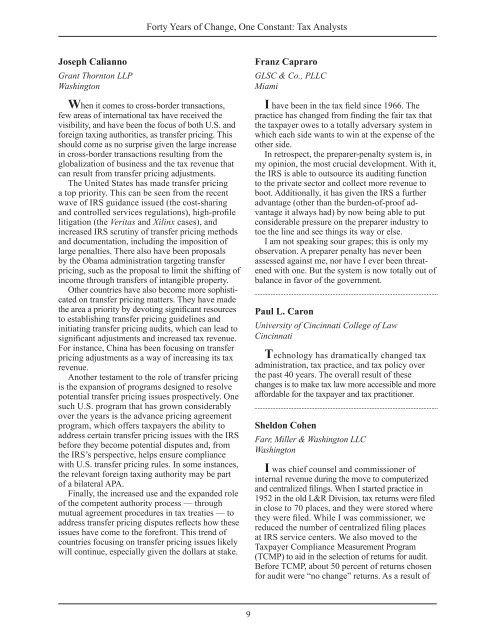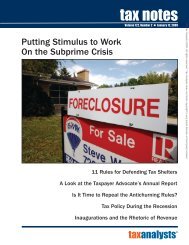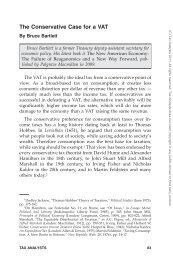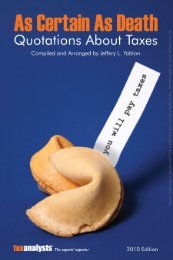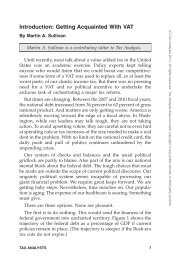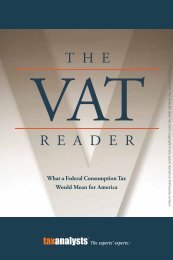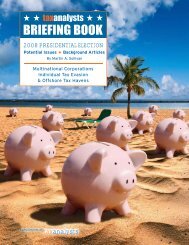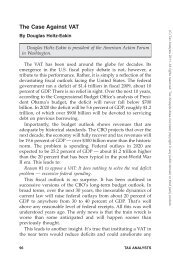Forty Years of Change, One Constant: Tax Analysts
Forty Years of Change, One Constant: Tax Analysts
Forty Years of Change, One Constant: Tax Analysts
You also want an ePaper? Increase the reach of your titles
YUMPU automatically turns print PDFs into web optimized ePapers that Google loves.
<strong>Forty</strong> <strong>Years</strong> <strong>of</strong> <strong>Change</strong>, <strong>One</strong> <strong>Constant</strong>: <strong>Tax</strong> <strong>Analysts</strong><br />
Joseph Calianno<br />
Grant Thornton LLP<br />
Washington<br />
When it comes to cross-border transactions,<br />
few areas <strong>of</strong> international tax have received the<br />
visibility, and have been the focus <strong>of</strong> both U.S. and<br />
foreign taxing authorities, as transfer pricing. This<br />
should come as no surprise given the large increase<br />
in cross-border transactions resulting from the<br />
globalization <strong>of</strong> business and the tax revenue that<br />
can result from transfer pricing adjustments.<br />
The United States has made transfer pricing<br />
a top priority. This can be seen from the recent<br />
wave <strong>of</strong> IRS guidance issued (the cost-sharing<br />
and controlled services regulations), high-pr<strong>of</strong>ile<br />
litigation (the Veritas and Xilinx cases), and<br />
increased IRS scrutiny <strong>of</strong> transfer pricing methods<br />
and documentation, including the imposition <strong>of</strong><br />
large penalties. There also have been proposals<br />
by the Obama administration targeting transfer<br />
pricing, such as the proposal to limit the shifting <strong>of</strong><br />
income through transfers <strong>of</strong> intangible property.<br />
Other countries have also become more sophisticated<br />
on transfer pricing matters. They have made<br />
the area a priority by devoting significant resources<br />
to establishing transfer pricing guidelines and<br />
initiating transfer pricing audits, which can lead to<br />
significant adjustments and increased tax revenue.<br />
For instance, China has been focusing on transfer<br />
pricing adjustments as a way <strong>of</strong> increasing its tax<br />
revenue.<br />
Another testament to the role <strong>of</strong> transfer pricing<br />
is the expansion <strong>of</strong> programs designed to resolve<br />
potential transfer pricing issues prospectively. <strong>One</strong><br />
such U.S. program that has grown considerably<br />
over the years is the advance pricing agreement<br />
program, which <strong>of</strong>fers taxpayers the ability to<br />
address certain transfer pricing issues with the IRS<br />
before they become potential disputes and, from<br />
the IRS’s perspective, helps ensure compliance<br />
with U.S. transfer pricing rules. In some instances,<br />
the relevant foreign taxing authority may be part<br />
<strong>of</strong> a bilateral APA.<br />
Finally, the increased use and the expanded role<br />
<strong>of</strong> the competent authority process — through<br />
mutual agreement procedures in tax treaties — to<br />
address transfer pricing disputes reflects how these<br />
issues have come to the forefront. This trend <strong>of</strong><br />
countries focusing on transfer pricing issues likely<br />
will continue, especially given the dollars at stake.<br />
Franz Capraro<br />
GLSC & Co., PLLC<br />
Miami<br />
I have been in the tax field since 1966. The<br />
practice has changed from finding the fair tax that<br />
the taxpayer owes to a totally adversary system in<br />
which each side wants to win at the expense <strong>of</strong> the<br />
other side.<br />
In retrospect, the preparer-penalty system is, in<br />
my opinion, the most crucial development. With it,<br />
the IRS is able to outsource its auditing function<br />
to the private sector and collect more revenue to<br />
boot. Additionally, it has given the IRS a further<br />
advantage (other than the burden-<strong>of</strong>-pro<strong>of</strong> advantage<br />
it always had) by now being able to put<br />
considerable pressure on the preparer industry to<br />
toe the line and see things its way or else.<br />
I am not speaking sour grapes; this is only my<br />
observation. A preparer penalty has never been<br />
assessed against me, nor have I ever been threatened<br />
with one. But the system is now totally out <strong>of</strong><br />
balance in favor <strong>of</strong> the government.<br />
Paul L. Caron<br />
University <strong>of</strong> Cincinnati College <strong>of</strong> Law<br />
Cincinnati<br />
Technology has dramatically changed tax<br />
administration, tax practice, and tax policy over<br />
the past 40 years. The overall result <strong>of</strong> these<br />
changes is to make tax law more accessible and more<br />
affordable for the taxpayer and tax practitioner.<br />
Sheldon Cohen<br />
Farr, Miller & Washington LLC<br />
Washington<br />
I was chief counsel and commissioner <strong>of</strong><br />
internal revenue during the move to computerized<br />
and centralized filings. When I started practice in<br />
1952 in the old L&R Division, tax returns were filed<br />
in close to 70 places, and they were stored where<br />
they were filed. While I was commissioner, we<br />
reduced the number <strong>of</strong> centralized filing places<br />
at IRS service centers. We also moved to the<br />
<strong>Tax</strong>payer Compliance Measurement Program<br />
(TCMP) to aid in the selection <strong>of</strong> returns for audit.<br />
Before TCMP, about 50 percent <strong>of</strong> returns chosen<br />
for audit were “no change” returns. As a result <strong>of</strong><br />
9


